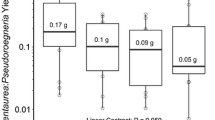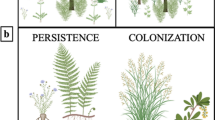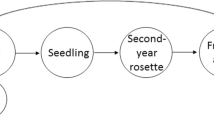Abstract
Invasions are dynamic as both the invading organism and the invaded ecosystem change. Intrinsic changes to the invader (invasion process) can involve population level genetic and reproductive changes. Extrinsic changes (invasion effect) occur to the environment that is invaded (e.g., alterations to the physical environment), to the invaded plant community (e.g., changes in species diversity and composition or evolutionary changes), or to insect herbivory. To investigate how invasions change through time, we investigated both the process and effect of a Phragmites australis invasion by comparing young and old P. australis stands within two Chesapeake Bay subestuaries. We quantified clonal richness of P. australis stands, vigor of the invader, herbivore damage, and plant community composition. Our results indicate that only the population-scale genetics (clonal richness, genetic distance) changed over the course of 40 years. Clonal richness was lower in the old P. australis stands, likely due to intraspecific competition and/or initial colonization by fewer genotypes. The mean genetic distance among clones within old stands was lower than within young stands, suggesting that clones within old stands were mostly closely-related, while young stands were likely established by seeds from nearby stands and so were more representative of the local area. Clones in different old stands were genetically more distant from each other than those in young stands were from clones in other young stands. This pattern suggested that old stands were established by independent colonization events, while young patches were established by a mixture of seeds from local stands, which generated the lower average genetic distance between clones across young stands. We found that community composition, plant vigor, and herbivore damage to stems were similar across different age stands, which indicated that the effect of P. australis invasion becomes stable within a few decades. Over longer periods, the intrinsic invasion process may be more dynamic than the invasion effect.



Similar content being viewed by others
References
Ahee JC, Sinclair BJ, Dorkena ME (2013) A new species of Stenodiplosis (Diptera: Cecidomyiidae) on florets of the invasive common reed (Phragmites australis) and its effects on seed production. Canadian Entomologist 145(3):235–246
Allee WC (1931) Animal aggregations, a study in general sociology. University of Chicago Press, Chicago
Ally D, Ritland K, Otto SP (2010) Aging in a long-lived clonal tree. PLoS Biology 8:8
Anderson MJ, Gorley RN, Clarke KR (2008) PERMANOVA+ for PRIMER: guide to software and statistical methods. Primer-e, Plymouth, p 214
Arnaud-Haond S, Duarte CM, Alberto F, Serrão EA (2007) Standardizing methods to address clonality in population studies. Molecular Ecology 16:5115–5139
Bart D, Burdick D, Chambers R, Hartman JM (2006) Human facilitation of Phragmites australis invasions in tidal marshes: a review and synthesis. Wetl Ecol Manag 14(1):53–65
Bertness MD, Ewanchuk PJ, Silliman BR (2002) Anthropogenic modification of New England salt marsh landscapes. Proceedings of the National Academy of Sciences of the United States of America 99(3):1395–1398
Blossey B, Schwarzlander M, Hafliger P, Casagrande R, Tewksbury L (2002) Common reed. In: Van Driesche R, Blossey B, Hoddle M, Lyon S, Reardon R (eds) Biological control of invasive plants in the Eastern United States. Forest Health Technology Enterprise Team, Morgantown
Bruvo R, Michiels NK, D’Souza TG, Schulenburg H (2004) A simple method for the calculation of microsatellite genotype distances irrespective of ploidy level. Molecular Ecology 13:2101–2106
Bullock JM, Clarke RT (2000) Long distance seed dispersal by wind: measuring and modelling the tail of the curve. Oecologia 124(4):506–521
Burdick DM, Konisky YA (2003) Determinants of expansion for Phragmites australis, common reed, in natural and impacted coastal marshes. Estuaries and Coasts 26(2):407–416
Cappuccino N (2004) Allee effect in an invasive alien plant, pale swallow‐wortVincetoxicum rossicum (Asclepiadaceae). Oikos 106(1):3–8
Chambers RM, Meyerson L, Saltonstall K (1999) Expansion of Phragmites australis into tidalwetlands of North America. Aquatic Botany 64(3–4):261–273
Chambers RM, Havens KJ, Killeen S, Berman M (2008) Common reed Phragmites australis occurrence and adjacent land use along estuarine shoreline in Chesapeake Bay. Wetlands 28:1097–1103
Clark LV, Jasieniuk M (2011) POLYSAT: an R package for polyploid microsatellite analysis. Molecular Ecology Resources 11(3):562–566
Corbin JD, D’Antonio CM (2012) Gone but not forgotten? Invasive plants’ legacies on community and ecosystem properties. Invasive Plant Science and Management 5(1):117–124
Crutsinger GM, Collins MD, Fordyce JA, Gompert Z, Nice CC, Sanders NJ (2006) Plant genotypic diversity predicts community structure and governs an ecosystem process. Science 313(5789):966–968
Čurn V, Kubátová B, Vávřová P, Křiváčková-Suchá O, Čížková H (2007) Phenotypic and genotypic variation of Phragmites australis: comparison of populations in two human-made lakes of different age and history. Aquatic Botany 86(4):321–330
Davis HG, Taylor CM, Lambrinos JG, Strong DR (2004) Pollen limitation causes an Allee effect in a wind-pollinated invasive grass (Spartina alterniflora). Proceedings of the National Academy of Sciences of the United States of America 101(38):13804–13807
Dennis B (2002) Allee effects in stochastic populations. Oikos 96(3):389–401
DeWoody JA, Schupp J, Kenefic L, Busch J, Murfitt L, Keim P (2004) Universal method for producing ROX-labeled size standards suitable for automated genotyping. Biology Techniques 37(3):348–352
Douhovnikoff V, Mcbride JR, Dodd RS (2005) Salix exigua clonal growth and population dynamics in relation to disturbance regime variation. Ecology 86(2):446–452
Drake JM (2004) Allee effects and the risk of biological invasion. Risk Analysis 24(4):795–802
Ellstrand NC, Roose ML (1987) Patterns of genotypic diversity in clonal plant species. Am J Bot 74(1):123–131
Eriksson O (1989) Seedling dynamics and life histories in clonal plants. Oikos 55:231–238
Eriksson O, Fröborg H (1996) “Windows of opportunity” for recruitment in long-lived clonal plants: experimental studies of seedling establishment in Vaccinium shrubs. Canadian Journal of Botany 74(9):1369–1374
Estrella S, Kneitel JM (2011) Invasion age and invader removal alter species cover and composition at the Suisun Tidal Marsh, California, USA. Diversity and Distributions 3(2):235–251
Farnsworth EJ, Meyerson LA (1999) Species composition and inter-annual dynamics of a freshwater tidal plant community following removal of the invasive grass, Phragmites australis. Biological Invasions 1:115–127
Findlay S, Groffman P, Dye S (2003) Effects of Phragmites australis removal on marsh nutrient cycling. Wetlands Ecology and Management 11:157–165
Hacker SD, Dethier MN (2012) Differing consequences of removing ecosystem-modifying invaders: significance of impact and community context to restoration potential. In: Rilov G, Crooks JA (eds) Biological invasions in marine ecosystems. Springer, Berlin
Ishii J, Kadono Y (2002) Factors influencing seed production of Phragmites australis. Aquatic Botany 72(2):129–141
Kettenring KM, Mock KE (2012) Genetic diversity, reproductive mode, and dispersal differ between the cryptic invader, Phragmites australis, and its native conspecific. Biological Invasions 14:2489–2504
Kettenring KM, Whigham DF (2009) Seed viability and seed dormancy of non-native Phragmites australis in suburbanized and forested watersheds of the Chesapeake Bay, USA. Aquatic Botany 91:199–204
Kettenring KM, McCormick MK, Baron HM, Whigham DF (2010) Phragmites australis (Common Reed) invasion in the Rhode River Subestuary of the Chesapeake Bay: disentangling the effects of foliar nutrients, genetic diversity, patch size, and seed viability. Estuaries and Coasts 33(1):118–126
Kettenring KM, McCormick MK, Baron HM, Whigham DF (2011) Mechanisms of Phragmites australis invasion: feedbacks among genetic diversity, nutrients, and sexual reproduction. Journal of Applied Ecology 48(5):1305–1313
King RS, DeLuca WV, Whigham DF, Marra PP (2007) Threshold effects of coastal urbanization on Phragmites australis (common reed) abundance and foliar nitrogen in ChesapeakeBay. Estuaries and Coasts 30:469–481
Koppitz H, Kuhl H (2000) To the importance of genetic diversity of Phragmites australis in the development of reed stands. Wetlands Ecology and Management 8:403–414
Koppitz H, Kuhl H, Hesse K, Kohl J-G (1997) Some aspects of the importance of genetic diversity in Phragmites australis (Cav.) Trin. Ex Steudel for the development of reed stands. Botanica Acta 110:217–223
Křiváčková-Suchá O, Vávřová P, Čížková H, Čurn V, Kubátová B (2007) Phenotypic and genotypic variation of Phragmites australis: a comparative study of clones originating from two populations of different age. Aquatic Botany 86(4):361–368
Lambert A, Casagrande R (2007) Characteristics of a successful estuarine invader: evidence of self-compatibility in native and non-native lineages of Phragmites australis. Marine Ecology Progress Series 337:299–301
Lambert AM, Winiarski K, Casagrande RA (2007) Distribution and impact of exotic gall flies (Lipara spp.) on native and exotic Phragmites australis. Aquatic Botany 86:163–170
Lambertini C, Gustafsson MH, Frydenberg J, Speranza M, Brix H (2008) Genetic diversity patterns in Phragmites australis at the population, regional and continental scales. Aquatic Botany 88(2):160–170
Lavoie C, Jean M, Delisle F, Létourneau G (2003) Exotic plant species of the St Lawrence River wetlands: a spatial and historical analysis. Journal of Biogeography 30(4):537–549
Legendre P, Legendre L (2012) Numerical ecology (vol. 20). Elsevier, Amsterdam
McCormick J, Somes HA (1982) The coastal wetlands of Maryland. Jack McCormick and Associates, Annapolis
McCormick MK, Kettenring KM, Baron HM, Whigham DF (2010a) Spread of invasive Phragmites australis in estuaries with differing degrees of development: genetic patterns, Allee effects and interpretation. Journal of Ecology 98(6):1369–1378
McCormick MK, Kettenring KM, Baron HM, Whigham DF (2010b) Extent and reproductive mechanisms of Phragmites australis spread in brackish wetlands in Chesapeake Bay, Maryland (USA). Wetlands 30:67–74
Minchinton TE, Simpson JC, Bertness MD (2006) Mechanisms of exclusion of native coastal marsh plants by an invasive grass. Journal of Ecology 94(2):342–354
Mitchell ME, Lishawa SC, Geddes P, Larkin DJ, Treering D, Tuchman NC (2011) Time-dependent impacts of cattail invasion in a Great Lakes coastal wetland complex. Wetlands 31(6):1143–1149
Niering WA, Warren RS, Weymouth CG (1977) Our dynamic tidal marshes: vegetation changes as revealed by peat analysis. The Connecticut Arboretum Bulletin (22)
Obbard DJ, Harris SA, Pannell JR (2006) Simple allelic-phenotype diversity and differentiation statistics for allopolyploids. Heredity 97(4):296–303
Orson RA, Warren RS, Niering WA (1987) Development of a tidal marsh in a New England river valley. Estuaries and Coasts 10(1):20–27
Pollux BJA, Jong MDE, Steegh A, Verbruggen E, van Groenendael JM, Ouborg NJ (2007) Reproductive strategy, clonal structure and genetic diversity in populations of the aquatic macrophyte Sparganium emersum in river systems. Molecular Ecology 16:313–325
Raicu P, Staicu S, Stoian V, Roman T (1972) The Phragmites communis Trin.chromosome complement in the Danube delta. Hydrobiologia 39:249–252
Rees GN, Baldwin DS, Watson GO, Perryman S, Nielson DL (2004) Ordination and significance testing of microbial community composition derived from terminal restriction fragment length polymorphisms: application of multivariate statistics. Antonie van Leeuwenhoek 86:339–347
Rice D, Rooth JE, Stevenson JC (2000) Colonization and expansion of Phragmites australis in upper Chesapeake Bay tidal marshes. Wetlands 20:280–299
Rooth JE, Stevenson JC, Cornwell JC (2003) Increased sediment accretion rates following invasion by Phragmites australis: the role of litter. Estuaries and Coasts 26(2):475–483
Saltonstall K (2002) Cryptic invasion by a non-native genotype of the common reed, Phragmites australis, into North America. Proceedings of the National Academy of Sciences of the United States of America 99:2445–2449
Saltonstall K (2003) Microsatellite variation within and among North American lineages of Phragmites australis. Molecular Ecology 12:1689–1702
Silvertown J (2008) The evolutionary maintenance of sexual reproduction: evidence from the ecological distribution of asexual reproduction in clonal plants. International Journal of Plant Sciences 169(1):157–168
Smithsonian Institution (1974) Investigations on Classification Categories for Wetlands of Chesapeake Bay Using Remotely Sensed Data. Annual Report. October 10, 1972 to October 9, 1973. Chesapeake Bay Center for Environmental Studies, Smithsonian Institution. Edgewater, MD
Strayer DL, Eviner VT, Jeschke JM, Pace ML (2006) Understanding the long-term effects of species invasions. Trends in Ecology and Evolution 21(11):645–651
Suding KN, Gross KL, Houseman GR (2004) Alternative states and positive feedbacks in restoration ecology. Trends in Ecology and Evolution 19(1):46–53
Taylor CM, Hastings A (2004) Allee effects in biological invasions. Ecology Letters 8(8):895–908
Taylor CM, Davis HG, Civille JC, Grevstad FS, Hastings A (2004) Consequences of an Allee effect in the invasion of a Pacific estuary by Spartina alterniflora. Ecology 85:3254–3266
Tewksbury L, Casagrande R, Blossey B, Hafliger P, Schwarzlander M (2002) Potential for biological control of Phragmites australis in North America. Biological Control 23(2):191–212
Tscharntke T (1999) Insects on common reed Phragmites australis: community structure and the impact of herbivory on shoot growth. Aquatic Botany 64(3):399–410
Tucker N (1938) A preliminary report on the salt marsh vegetation of Long Island, New York. New York State Museum, New York
Utsumi S, Ando Y, Craig TP, Ohgushi T (2011) Plant genotypic diversity increases population size of a herbivorous insect. Philosophical Transactions of the Royal Society B 278(1721):3108–3115
Vitousek PM (1990) Biological invasions and ecosystem processes: towards an integration of population biology and ecosystem studies. Oikos S57:7–13
Windham L, Meyerson LA (2003) Effects of common reed (Phragmites australis) expansions on nitrogen dynamics of tidal marshes of the northeastern US. Estuaries and Coasts 26(2):452–464
Acknowledgments
The authors are grateful to Louise McKenzie and Matthew Van Scoyoc for critical statistical advice, and Susan Cook-Patton for thoughtful comments on this manuscript. The manuscript greatly benefitted from comments by the editor and external reviewers. Jay O’Neill, Liza McFarland, and Rachel Dutko assisted in the lab and field. All microsatellite analyses were carried out at the Smithsonian Laboratory of Analytical Biology. This research was funded by NOAA (grant #NA09NOS4780214). A Smithsonian Institution Predoctoral Fellowship, Utah State University Ecology Center Student Research Support, Society of Wetland Scientists, and Delta Waterfowl provided additional support for EH.
Author information
Authors and Affiliations
Corresponding author
Rights and permissions
About this article
Cite this article
Hazelton, E.L.G., McCormick, M.K., Sievers, M. et al. Stand Age is Associated with Clonal Diversity, but Not Vigor, Community Structure, or Insect Herbivory in Chesapeake Bay Phragmites australis . Wetlands 35, 877–888 (2015). https://doi.org/10.1007/s13157-015-0678-7
Received:
Accepted:
Published:
Issue Date:
DOI: https://doi.org/10.1007/s13157-015-0678-7




